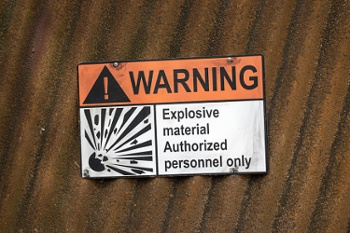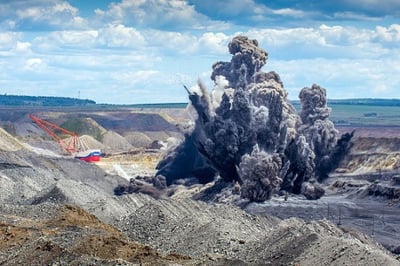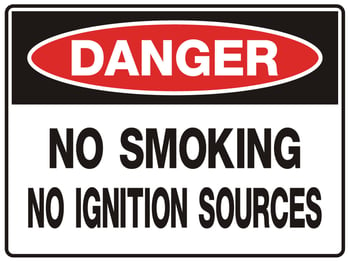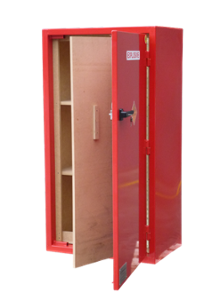When you’re working with Class 1 Explosive Substances, the separation distances for explosive storage and detonators are a key safety consideration. In this post, we look at the requirements that relate to the distances required for explosive storage on the jobsite. This includes proximity to detonators, as well as authorised works, protected works and ignition sources.
Reducing Risk
How and where you store your detonators and explosives will affect the level of risk that your organisation faces with your Class 1 dangerous goods.
Risk reduction should be focused on reducing the communication of explosion between different storages, as well as injury and property damage.
Class 1 Explosive Substances require strict requirements for their safe handling and storage. Whether they are used on a mining site, for construction purposes or in the events industry, dynamite, explosives and pyrotechnics are part of one of the most volatile dangerous goods classes. Handle or store these items in a non-compliant manner and risks can result in fatalities, mass property destruction and harm to the surrounding environment and community.

If your organisation carries Class 1 substances or articles, you must ensure that your handling and storage practices reduce the risk of harm to people, property and the environment.
To reduce the likelihood of an explosive incident, there are requirements in place that dictate how far explosive substances and detonators should be stored in workplaces. These highly detailed requirements are found in the Australian Standard AS 2187-1998 - Explosives - Storage, transport and use.
We’ll go into further detail about these requirements a little later in the blog.
How Do Class 1 Substances Explode?
Explosions are defined as the rapid conversion of a Class 1 substance to gas through the process of detonation. Explosive substances must be initiated, or detonated, for the material to become explosive.

Explosives require compliant storage that adheres to the detailed requirements of the Australian Standards.
As a small device necessary for the detonation of explosive substances, detonators (otherwise known as blasting caps) are required for the activation of explosive work activities, such as rock blasting or tunnelling.
REMEMBER: Explosives require a permit or licence for storage. There are various permits or licences available depending on the product (and volume) that you’re carrying. For example, there are specific licences for the storage of propellant powders, fireworks and blasting explosives. Check with your state or territory to find out more about the necessary permits and licences, as well as the obligations that relate to explosive storage licence holders.
During a detonation, the explosive material mass will rapidly expand at great velocity, resulting in extremely high pressure and temperatures. The effect of this is the shattering force that you can witness when viewing a detonated explosive.
The velocity of detonation, known as VOD, is a marker for the power of the explosion. It is obtained through measuring the rate of the detonation wave as it travels along an explosive column. The larger the VOD, the more power the explosion will have.
Types Of Explosives
There are various types of explosives including low, industrial and high explosives.
Low explosives are Class 1 items such as gunpowder or fireworks. They generally have a velocity (or speed) of less than 2000 metres per second (m/s). They are the least powerful of all explosive types.
Industrial explosives are those Class 1 substances that are used most commonly in Australian workplaces. These include explosives for a range of works such as quarrying, road construction, mineral exploration and surface mining. Industrial explosives have a higher velocity than low explosives, up to 7000 m/s. This makes industrial explosives powerful substances that pose extreme risk for the operators and organisations that handle and store them.
High explosives have the most power of all Class 1 substances, with a velocity in excess of 7000 m/s. This type of explosive is used for military purposes. Examples of high explosives include high melting explosives (HMX) and Pentaerythritol tetranitrate (PETN).
Separation Distances
In Section 3.2.3 of the Australian Standard AS 2187.1-1998, it explains the separation distances between storage of explosives and detonators.
The distance between your detonators and explosives is different depending on the number of detonators that you're holding, as well as if your other magazines are mounded or unmounded.
For magazines that are mounded, the separation distance is as follows:
| Max number of detonators to other magazine (Classification Code 1.1B) | Separation distance in metres (m) |
| 2,000 | 3m |
| 5,000 | 3m |
| 10,000 | 3.5m |
| 20,000 | 4.5m |
| 50,000 | 9m |
For magazines that are unmounded, the separation distance is greater than those of mounded magazines, which offer more protection.
The details are as follows:
| Max number of detonators to other magazine (Classification Code 1.1B) | Separation distance in metres (m) |
| 2,000 | 10m |
| 5,000 | 10m |
| 10,000 | 10m |
| 20,000 | 13m |
| 50,000 | 18m |
Other Separation Requirements
There are other requirements that relate to the distances between storage of explosives.
These include:
- Protected works
- Authorised works
- Vulnerable facilities
- Other explosives storage
- Process building
- Ammonium nitrate storage
When determining the placement of your explosive stores, you must consider the net explosive quantity, or NEQ, of your Class 1 substances.
You must then determine the required separation distances to detonators, as well as protected and associated works.
IMPORTANT: A thorough risk assessment should be conducted for any business looking to store Class 1 explosives or detonators. The complexity of the separation requirements for explosive substances and articles requires great consideration and knowledge. You may wish to work with a Dangerous Goods Consultant who can assist with your explosive storage requirements.
Ignition Sources
When it comes to explosives and ignition, there are a multitude of workplace activities and items which can result in your Class 1 substances causing an explosion.
Avoid any activities which could cause:
- Heat
- Flames
- Friction
- Spark
- Impact
- Static electricity
Your operations should develop strict procedures and conduct up-to-date training for staff, supervisors and contractors on how to reduce the risk of ignition and static electricity.
It’s also important to ensure that you have adequate safety equipment available for the housekeeping and upkeep of your explosive magazine.

Any work practices, equipment or devices that may ignite Class 1 substances must be kept separated from stores of detonators and explosives.
The safety equipment should not produce sparks or static and may include:
- Anti-static items including shoes, clothing and brooms
- Fire-retarding clothing
- Non-ferrous dustpan
- Compliant portable fire-extinguisher
REMEMBER: Any work activities that may result in ignition be prohibited from explosive handling and storage areas by a distance of at least 8 metres.
Prohibited Articles and Materials
Your magazine should also be free from prohibited articles and materials which may increase the risk of explosion.
As part of your regular housekeeping routine, you should ensure that the following items are not brought into your explosive magazine or detonator store.
- Combustible materials
- Ignition sources
- Articles which may cause fire or explosion
- Empty packages
- Loose containers
- Rubbish or waste of any kind
- Tools not related to the operation of the store
- Other dangerous goods
- Any device which emits a frequency including mobiles and radio transmitters
- Intoxicants
The maintenance of your Class 1 magazine is just as important as the construction of the store itself. If your magazine isn’t maintained to meet your compliance obligations, it won’t be capable of providing a safe storage space for your explosives or detonators.
General Housekeeping
In addition to the above requirements, it’s also important to maintain a high level of cleanliness in your Class 1 stores, as this assists with risk reduction.
Consider the cleanliness and maintenance of your explosive cabinet or magazine.
General considerations for housekeeping at your site should include:
- Only using cleaning tools which are compatible with the contents of your magazine
- Cleaning up any spillage immediately and in accordance with operational procedures
- Ensuring the floor of the explosive magazine is free of dirt and grit
Are You Storing Your Explosives and Detonators Safely?
While the requirements for the storage of explosives and their separation from detonators can be a complex issue, there is a simple solution. If you store your explosives in a dedicated steel magazine that’s manufactured in full conformance with Australian Standards, you’ll be providing protection for your people, property and the environment. Choosing to store your detonators in a separate steel magazine, located away from your explosives, will contain each type of Class 1 material in a safe, compliant storage environment. You also won't be required to separate these cabinets, as they are constructed with a solid wall barrier that acts as a segregation barrier.
However, it’s important to note that Class 1 substances and articles aren’t the only dangerous goods that require segregation and separation. To reduce chemical risk in your organisation, you must ensure that your dangerous goods are properly segregated from incompatible classes of chemicals. To learn more about this topic, you can access our free eBook, How To Segregate Incompatible Classes of Dangerous Goods. Download your guide to read today and reduce risk in your chemical handling and storage areas.
Joining the team as a Dangerous Goods Storage Consultant, Melissa Hampton became Storemasta's Marketing Manager in late 2021. With extensive knowledge and experience in chemical compliance, Melissa is responsible for leading the Marketing team and helping shape their marketing strategy. In her spare time, you can find Melissa hiking, swimming and enjoying the great outdoors in beautiful north-west Tasmania.
